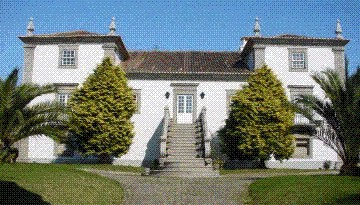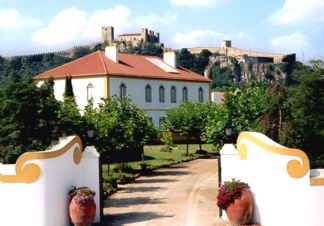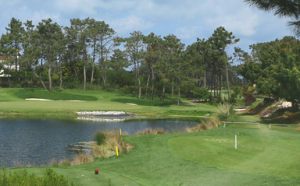|
| |
|
| |
Combines Culture and Courses
By Carla Harvey, TravelGolf.com StaffWriter
With thanks to Carla Harvy and the editor of TravelGolf.com
Viana do Castelo welcomes with a devil- may-care attitude and an appealing
raffish quality that seems quite appropriate to its status as the Minho’s
leading seaside resort. Everyone seems to have a good time here. Given
a diversity of shopping and an equal number of intriguing restaurants,
it’s not difficult to understand the contentment.

The nine-hole course at Quinta da Barca Golf
Club is part of a resort complex and no less attractive for being
so. Serving as a good example of well-controlled real estate development,
its definition as a golf course is demanding of attention and a pleasure
to play. Built alongside a freshwater marina on the Cávado river,
it is a few kilometres from the village of Esposende. Alternate tees allow
a further 9 holes for the golfer who insists a game is not a game without
the full complement; an additional nine holes are under design at present.
Even as it stands, Quinta da Barca is a long course; just over 4,000 metres with three par 4 holes that make it an adequate challenge to keep golfers on their toes. No fewer than three lakes lend beauty and hazard to play. The first four holes are sheltered by pine trees while the others holes are riverside, running back up to the clubhouse. Perhaps the dogleg on 8 is the most demanding on the course: it is protected by a lake and the river; overshoot and the certainty is a watery grave in the Cávado.
Very popular with residents, the club house restaurant has an innovative
menu and friendly atmosphere.

To be perfectly frank, I explored Estela Golf
Course in a fog that would have put ‘Wuthering Heights’ to shame.
Still, I knew that I was next to the sea because I could smell the delicious
salt tang of it. As I was in a golf buggy, I must be on a golf course.
And taking this little tale to logical conclusion, Estela is the only links
course in northern Portugal; therefore here am I. All of this aside, locals
advised playing the course during the summer months after mid-day, by which
time the mist has been burned off by the sun.
Returning the next afternoon to see what I had missed in terms of a view, I was impressed. Greens were planned to make the most of these vistas: most are elevated. The Minho coastline is startling and Estela follows it for some three kilometres. Water is omnipresent with two lakes adding to the challenge. It is the wind, however that is most influential on play – that and the sand dunes lying seaside of many fairways. One such hole is 5, a Par 5 which almost begs you to shoot out of bounds. Number 13 is also tricky: long and hugging the dunes, it requires thoughtful accuracy. Heading for the green on 10 means heading for the bunkers, as three sides of the green are fraught with them.
Estela has a sophisticated restaurant and bar area that take full advantage
of the views, a good pro shop and spacious changing areas. The course is
one of the few visited that is easily played without a buggy.

A manor house whose location is inimitable, Quinta
do Monteverde lies one kilometre from the sea. The beach rolls
on and on; sand dunes and unspoilt stretches lending a wonderful sense
of isolation to the surroundings. Golfers who are keen beachcombers will
enjoy this as much as the game.
Quinta da Monteverde was constructed in the 16th century. It has been completely renovated during the past three years, although care has been taken to protect architectural features of importance. Within the walled estate are the main house and three workers’ cottages that have been re-built in order to provide additional one- bedroom accommodation. These cottages are supplied with microwave and electric kettle; guests are served breakfast in an adjacent small building. There is a large living room area with a fireplace for communal use.
Three double bedrooms and a suite are located in the central house. Sitting rooms and a satellite TV are provided for indoor relaxation, while a swimming pool, tennis courts and bicycles are available for open air enjoyment.
A short stroll brings you to the Paradise Restaurant, and while I would
not vouch for its equation with heaven, I would praise its very excellent
and reasonably priced fish. Also within walking distance is a small fishing
village where other restaurants can be found.

Before going on to Praia d’el Rey, I took a break at Casa
d´Obidos. Doña Helena Sarmento slipped a glass of
port wine into my hand the moment I stepped through the doorway. This sort
of generosity was typical of the family and their kind attitude towards
guests.
Some fortunate American golfers have already discovered and re-visited Casa d’ Óbidos. One group of six couples rented all rooms available for a golfing holiday last year and are expected back shortly. They set up a little bar in the upstairs lounge, and when they returned from golf, they played billiards and card games in the opulent upstairs lounge. Two guest cottages are charming and completely equipped for self-catering.
A pool is set below in the gardens and there is a tennis court. Riding facilities are nearby. Óbidos is a visitor destination of note: called the ‘Wedding City’, it is the traditional gift of Portuguese Kings to their wives.
Restaurants in the area include three next door to the church and accessible on foot from the house. A visit to the Pousada is a must.
Casa d’Óbidos serves what is arguably the best breakfast on the manor house tour: from five styles of bread, muffins, cakes, ham, cheese, fluffy scrambled eggs and bacon, cereals, freshly squeezed juice, kiwis, melon and gallons of just perfect coffee. What a set up for a game of golf. Which is what I had to do in order to offset breakfast.
Praia d’el Rey is reputed to be one of Portugal’s finest. Designed by Cabell Robinson, it is a championship course that boasts marvelous fairways and perfectly manicured greens. Even the bunkers are pro-ative: left to their own devices, sunbathers tend to stretch out in them, risking the wrath of Caddie Master, Jim Lambert.
Roughs are made rougher by the presence of a sponge-like grass that
insidiously attempts to digest anything that lands in it. Jim advises taking
the strokes rather than adding up two-digit scores.

From Number 12 through 15,play is overlooking the Atlantic: sometimes
windy, always stunning. The last three holes are all uphill to the 18th
green and the way is not without potential disaster. A gap to the 16th
green is narrow, requiring painstaking accuracy. Further challenge is added
by Number 17, a 523-metre hole that is one of the longest Par 5s in Portugal;
17 is regarded as the most difficult hole on the course.
Before the end of 2001, a golf academy with state-of-the-art analysis equipment will be in place. The teaching area will thus be concentrated in one area and it will be an imposing venue for sharpening skills.
Golfers should be aware that Praia d’el Rey’s dress code prohibits the wearing of tennis shoes, jeans, tennis shorts, swimming trunks and t-shirts on the golf course.
Praia d’el Rey was my last stop on the Portuguese circuit. In many ways it was characteristic of central and northern clubs in the country. I found that in Portugal, golf favours the player.
Courtesy reigns. Real estate on the fairways is at a minimum, although there are signs of change in this respect. Golfers move comfortably from hole to hole, unhurried, playing the game as an antidote to stress rather than an extension of it. The absence of marshalls pounding around after golfers is a welcome one. Ten-minute tee times appear to be typical (when necessary), although further north at Ponte de Lima, the luxurious experience of not having to book at all is considered the norm – exceptions being at weekends and holidays.
For the Portuguese man-on-the-street, golf is still a relatively new sport. Until recently, golf was too expensive to take up on a regular basis. Jaoa Silva, Course Secretary at Amarante Golf Club says, “To play fifteen years ago, you were either very rich or worked on the golf course.” Jaoa was one of the first participants in the government-sponsored scheme aimed at getting young people interested in golf. Now a Handicap 4, Silva plays in competitions throughout the country.
High season in central Portugal is from March through May, so a good time to visit with weather to match is during the summer months, when temperatures average a comfortable 30º, with a prevailing fresh breeze from the north. Within an hour’s drive of Lisbon, more than a dozen good courses are open to the public. In the north, eight courses are in play.
| PORTUGAL - ACCOMMODATION BY TYPE | |||
| Portugal hotels | Pousadas | Manor Houses | Portugal inns |
| Portugal villas | Portugal cottages with shared pool | Golf Courses | |
| PORTUGAL - ACCOMMODATION BY REGION | |||
| Algarve | Alentejo | Lisbon Coast | Tagus Valley |
| Beiras | Porto and Douro | Alto Minho | Azores and Madeira |
| SPAIN | |||
| Paradores of Spain | |||